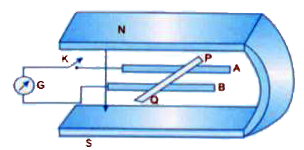A metallic bob A oscillates throgh the space between the poles of an electromagnet . The oscillation are more quickly damped when the circuit is on, as compared to the case when the circuit is off. Explain.

Step by step video & image solution for A metallic bob A oscillates throgh the space between the poles of an electromagnet . The oscillation are more quickly damped when the circuit is on, as compared to the case when the circuit is off. Explain. by Physics experts to help you in doubts & scoring excellent marks in Class 12 exams.
Topper's Solved these Questions
- BOOK - HC VERMACHAPTER - ELECTROMAGNETIC INDUCTIONEXERCISE - Objective 112videos
ELECTROMAGNETIC INDUCTION
- BOOK - HC VERMACHAPTER - ELECTROMAGNETIC INDUCTIONEXERCISE - Objective 210videos
ELECTROMAGNETIC INDUCTION
- BOOK - HC VERMACHAPTER - ELECTROMAGNETIC INDUCTIONEXERCISE - Worked Out Examples29videos
ELECTROMAGNETIC INDUCTION
- BOOK - HC VERMACHAPTER - ELECTRIC FIELD AND POTENTIALEXERCISE - Exercises75videos
ELECTRIC FIELD AND POTENTIAL
- BOOK - HC VERMACHAPTER - ELECTROMAGNETIC WAVESEXERCISE - Exercises9videos
ELECTROMAGNETIC WAVES
Similar Questions
Knowledge Check
- Question 1 - Select One
In an oscillator when the signal from the output circuit is applied to input of the circuit then it called
AfeedbackBripple factorCform factorDrefractive index - Question 2 - Select One
A small coil is introduced between the poles of an electromagnet so that its axis coincides with the magnetic field direction. The number of turns is n and the cross sectional area of the coil is A. When the coil turns through 180∘ about its diameter, the charge flowing through the coil is Q. the total resistance of the circuit is R. what is the magnitude of the magnetic induction?
AQRnAB2QRnACQn2RADQR2nA - Question 3 - Select One
A small coil is introduced between the poles of an electromagnet so that its axis coincides with the magnetic field direction. The cross-sectional area of the coil is equal to S=3.0mm2, the number of turns is N=60. When the coil turns through 180∘ about its diameter, a galvanometer connected to the coil indicates a charge q=4.5μC flowing through it. Find the magnetic induction magnitude between the poles, provided the total resistance of the electric circuit equals R=40Ω.
A2.5TB1.5TC0.5TD5T
When an ammeter is put in series of a circuit, does it record slightly less or more than the actual current in the circuit ? Explain.
View SolutionThe motion of copper plate is damped when it is allowed to oscillate between the two poles of a magnet. What is the cause of this damping?
View SolutionRenowned physicist Foucault (1819 - 1868) discovered that induced currents are produced in bulk pieces of conductors on subjecting them to changing magnetic flux. Flow pattern of these induced currents resemble swirling eddies in water and due to this reason these induced currents are called 'eddy currents'.
If a freely suspended metal plate is allowed to swing like a simple pendulum between the pole pieces of a strong magnet, it is found that the motion is damped on account of setting up of eddy currents in the metal plate.
Eddy currents are undesirable since they cause dissipation of electrical energy in the form of heat. Coils of transformers, electrical motors and other such devices are wound on a metallic core and in such devices a large amount of electrical energy is wasted during their operation due to eddy curents.
However, eddy currents are used to advantage in certain applications like magnetic braking in trains, moving coil galvanometers, induction furnace, a.c. induction motors, electric power meters, inducto thermy devices etc.
(a) What are eddy currents ?
(b) Why are they termed so?
(c) Briefly explain the mechanism of eddy currents.
(d) What is electromagnetic damping ?
(e) How is electromagnetic damping utilised in a moving coil galvanometer ?View SolutionThe motion of copper plates is damped when it is allowed to oscillate between the two poles of a magnet. If slots are cut in the plate, how will damping be affected ?
View SolutionFig. 6.05 shows a metal rod PQ resting on the smooth rails AB and positioned between the poles of a permanent magnet. The rails, the rod, and the magnetic field are in three mutual perpendicular directions. A galvanometer G connects the rails through a switch K. Length of the rod = 15 cm, B = 0.50 T, resistance of the closed loop containing the rod = 9.0mΩ. Assume the field to be uniform.
(a) Suppose K is open and the rod is moved with a speed of 12cms−1 in the direction shown. Give the polarity and magnitude of the induced emf.
(b) Is there an excess charge built up at the ends of the rods when K is open ? What if K is closed ?
(c) With K open and the rod moving uniformly, there is no net force on the electrons in the rod PQ even though they do experience magnetic force due to the motion of the rod. Explain.
(d) What is the retarding force on the rod when'K is closed ?
(e) How much power is required (by an external agent) to keep the rod moving at the same speed (=12cms−1) when Kis closed ? How much power is required when K is open ?
(f) How much power is dissipated as heat in the closed circuit? What is the source of this power?
(g) What is the induced emf in the moving rod if the magnetic field is parallel to the rails instead of being perpendicular?
 View Solution
View Solution

